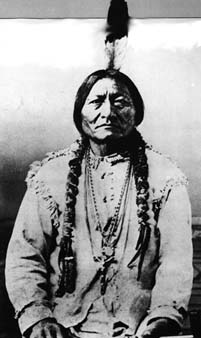Sitting Bull

Bibliography
8th American History
2005 Project

Sitting Bull |
|
| Sitting Bull meant Tatanka-Iyotanka. Sitting Bull was first known as Slow, but when he went to was, for his first time at the age of 14, he charged the enemy with amazing courage. When everyone saw Slow charging toward the enemy they quickly stopped waiting and charged with Slow. The enemy was frightened by Slow's courage, and quickly retreated. He was then known to become a great and very powerful leader. His father was so proud of him he gave Slow the name Sitting Bull. | |
 |
Sitting Bull was born in 1831 in an area known to Lakota's as "Many Caches". This place was known for having many storage pits. "Many Caches" was located around an area of the Grand River in the Indian Territory. (now South Dakota) Even as a young boy, Sitting Bull was beginning to be seen as becoming a future leader. Later on in sitting Bull's life, he would become chief of all the Sioux. |
| While being a leader, Sitting Bull drastically increased Souix hunting territory. in 1867, Sitting Bull became chief of the entire Souix nation. Sitting Bull was also known for being a leader of the Strong Heart Society and also The Silent Eaters, a group concerned with tribal welfare. Sitting Bull was also a Lakota chief that united tribes for their survival on the northern plains. Sitting Bull was a good leader. He was a very skilled warrior, a peace maker, very popular in his tribe, had sympathy for his poor and needy, he shared food and even gave away horses to his warriors. Sitting Bull was also very religious. Everything he prayed for he received. | |
| Sitting Bull's warfare was one of the most important times in Indian history. He went to his first battle at the age of 14 in a raiding party on a Crow village, and had his first experience with the U.S. army in June of 1863. During the next year he fought with the U.S. arny at the Battle of Killdeer Mountain. During 1865 he led an attack on a newly established fort called Fort Rice in North Dakota. Known for his insight and bravery during this battle, he later became chief of the Lakota in 1865. In 1874 Custer confirmed the discovery of gold in a sacred place to many Lakota's as the Black Hills, but settlers couldn't enter the Black Hills because of the Fort Laramie Treaty. Ignoring this treaty, settlers and prospectors invaded Lakota Territory forcing the Lakota to defend their land. During Custer's last battle, Custer surrounded Sitting Bull's camp with the 7th Calvary and le a straight attack on the camp. After retreating to a hill, Custer was killed along with 3/4 of his regiment. In 1885 Sitting Bull left the reservation and began working for Buffalo Bill Wild West show earning $50 a week. After leaving Buffalo Bill's, Sitting Bull went back close to where he was born and started living the way he used to, but sent his children to a Christian school thinking that they would need to read and write. In 1877 Sitting Bull left along with his followers into Canada. On May 10, 1883, Sitting Bull rejoined the rest of his tribe, but was forced to work in a field by an Indian agent. Four years after the battle with General Custer at the Little BigHorn, Sitting Bull was forced to surrender because he was seeing that it was becoming hard to feed his people because of the close to extinction of the buffalo. | |
| Sitting Bull's death was very tragic. He was informed that the Ghost Dance would be occurring soon. Authorities feared that Sitting Bull, still known as a spiritual leader, would join the Ghost Dance. Then when Lakota police broke up the ritual, a gunfight occurred, during this gunfight Sitting Bull was shot in the head, killing him. Sitting Bull was buried at Fort Yates in North Dakota. | |
|
Bibliography |
|
| Willow Bunch Museum, "History of Sitting Bull"<http://collections.ic.gc.ca/beaupre/promme92.htm> 5-9-05 | |
| PBS-The West, "Sitting Bull"<http://www.pbs.org/weta/thewest/people/s_z/sittingbull.htm>5-11-05 | |
| Sitting Bull, <http://jbtank.com/indians/sittingbull.html>5-11-05 | |
| Spectrum, Sitting Bull, < http://www.incwell.com/Biographies/SittingBull.html >5-12-05 | |
| MIDI database, Movie Themes,<http://themes.mididb.com/movies/> | |
| Tripod, sitting bull, < http://members.tripod.com/~RFester/lakota.html> 5-12_05 | |
| Cody Martinson
8th American History 2005 Project |
|